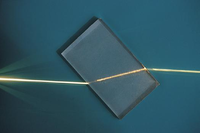
Photo from wikipedia
Combined modulus and impedance spectra are widely employed to explore electrical inhomogeneity and carriers' behaviors in dielectric ceramics based on equivalent circuit. However, discrepancies are found between practical dielectric responses… Click to show full abstract
Combined modulus and impedance spectra are widely employed to explore electrical inhomogeneity and carriers' behaviors in dielectric ceramics based on equivalent circuit. However, discrepancies are found between practical dielectric responses and widely proposed equivalent circuits. Taking ZnO varistor ceramics as an example, a low-frequency dielectric relaxation, which can be detected in practical dielectric spectroscopy, is overlooked in simulated dielectric spectroscopy based on the proposed equivalent circuit according to modulus and impedance spectra. Therefore, equivalent circuits are frequently incomplete because the real low-frequency dielectric response is unable to be characterized from them. The problem originates from debatable understanding of frequency responses in modulus and impedance spectra. The low-frequency peak in modulus spectroscopy is proved originating from DC conductance instead of a real dielectric relaxation and the involvement of DC conductance component makes a low-frequency dielectric relaxation unable to be characterized in modulus spectroscopy. Therefore, improved dielectric spectroscopy eliminating the component of DC conductance is proposed and a clear peak corresponding to the low-frequency dielectric relaxation appears. In addition, a modified equivalent circuit which is in accordance with practical dielectric responses in not only modulus and impedance spectra but also dielectric spectroscopy is presented.Combined modulus and impedance spectra are widely employed to explore electrical inhomogeneity and carriers' behaviors in dielectric ceramics based on equivalent circuit. However, discrepancies are found between practical dielectric responses and widely proposed equivalent circuits. Taking ZnO varistor ceramics as an example, a low-frequency dielectric relaxation, which can be detected in practical dielectric spectroscopy, is overlooked in simulated dielectric spectroscopy based on the proposed equivalent circuit according to modulus and impedance spectra. Therefore, equivalent circuits are frequently incomplete because the real low-frequency dielectric response is unable to be characterized from them. The problem originates from debatable understanding of frequency responses in modulus and impedance spectra. The low-frequency peak in modulus spectroscopy is proved originating from DC conductance instead of a real dielectric relaxation and the involvement of DC conductance component makes a low-frequency ...
Journal Title: Journal of Applied Physics
Year Published: 2019
Link to full text (if available)
Share on Social Media: Sign Up to like & get
recommendations!